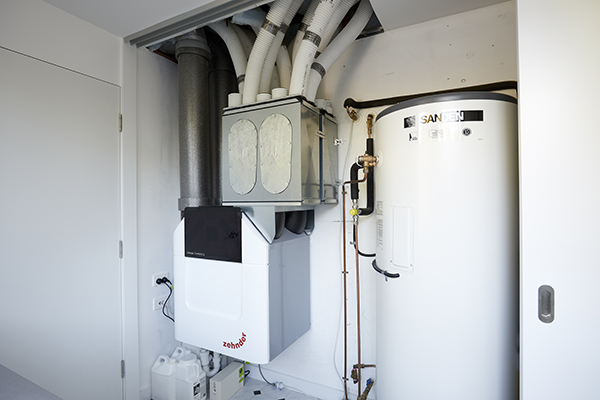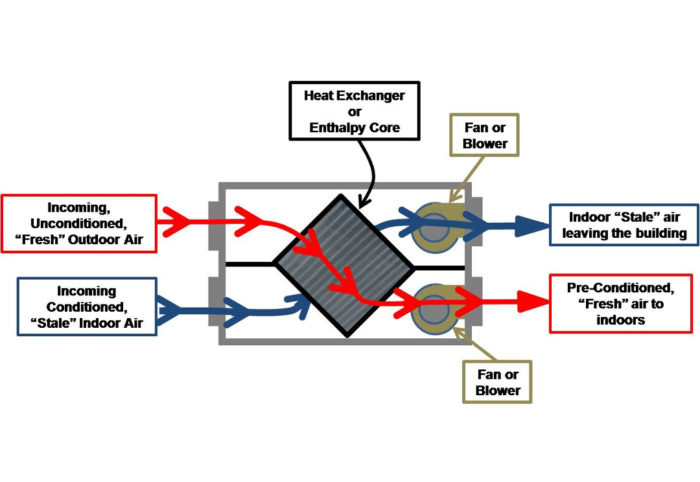HRV For Beginners: A Simple Guide
The All-Inclusive Guide to the Uses of Heat Recovery Ventilation in Modern Structures
Heat Recovery Ventilation (HRV) systems stand for a considerable improvement in building modern technology (HRV Heat Recovery Ventilation). They offer a method for trading stagnant indoor air with fresh exterior air while reducing energy loss. This strategy not only boosts interior air quality but likewise adds to energy efficiency in both household and commercial structures. Understanding the numerous applications and benefits of HRV can disclose its important duty in contemporary design and sustainability efforts. The ramifications of this innovation deserve exploring additionally
Comprehending Heat Recovery Ventilation Equipments

Several contemporary buildings focus on energy effectiveness, recognizing heat recovery ventilation (HRV) systems is crucial for maximizing indoor air quality and minimizing power usage. HRV systems function by moving heat from stagnant interior air to inbound fresh air, successfully keeping comfy indoor temperatures while lessening power loss. These systems include a heat exchanger, fans, and ductwork that facilitate the blood circulation of air. Throughout winter months, HRV devices record and reuse warm from the outbound air, while in summer season, they can assist cool down incoming air. By constantly trading air, HRV systems additionally lower moisture and the focus of interior contaminants. Correct installation and maintenance of HRV systems are essential for their efficiency and performance in enhancing total building performance and comfort.
Benefits of Heat Recovery Ventilation
Heat recovery ventilation systems offer various benefits that enhance both power performance and interior air quality in modern-day structures. By recording and recycling energy from exhaust air, these systems considerably minimize cooling and heating prices, bring about reduced energy intake. They preserve a steady circulation of fresh outside air, reducing the danger of indoor air contaminants and allergens. This continuous exchange aids control moisture levels, protecting against mold growth and ensuring a healthier living setting. Additionally, HRV systems add to sustainability objectives by decreasing general carbon impacts. Their capability to enhance ventilation without giving up thermal comfort makes them a beneficial addition to modern building layout, promoting both financial and environmental advantages.
Applications of HRV in Residential Buildings
As home owners progressively prioritize energy effectiveness and indoor air top quality, the applications of heat recuperation ventilation (HRV) systems in household structures have ended up being more common. HRV systems are particularly advantageous in securely secured homes, where preserving fresh air blood circulation is necessary for stopping moisture buildup and interior toxins. They efficiently move warm from outgoing stale air to inbound fresh air, decreasing power prices connected with home heating and cooling. In addition, HRVs can enhance comfort degrees by regulating humidity and temperature. They are also versatile for various domestic styles, consisting of single-family homes and multi-unit structures. Generally, incorporating HRV systems sustains lasting living methods while making sure a healthier indoor atmosphere for residents.
HRV in Industrial and Commercial Setups
In industrial and industrial settings, the implementation of heat recovery air flow (HRV) systems has ended up being progressively vital for enhancing energy effectiveness and maintaining air quality. These systems effectively move warm from exhaust air to incoming fresh air, decreasing the need for additional home heating or air conditioning. This not only lowers power expenses however also adds to sustainability efforts. Industries such as production, warehousing, and office this link buildings benefit considerably from HRV systems, as they aid regulate temperature level and moisture levels, ensuring a comfortable and effective setting. In addition, HRV systems help in eliminating contaminants and excess moisture, improving interior air high quality. As laws around air high quality end up being more stringent, the fostering of HRV innovation is likely to expand, making it a critical part of modern-day commercial and industrial infrastructure.
Future Trends in Heat Recovery Ventilation Modern Technology

Frequently Asked Questions
Just How Does Heat Recovery Ventilation Effect Indoor Air High Quality?
Heat recovery ventilation substantially boosts click for source interior air quality by continually exchanging stagnant interior air with fresh exterior air while recouping power. This process minimizes toxins, keeps perfect humidity levels, and guarantees a healthier setting for owners.
Can HRV Solutions Be Set Up in Existing Structures?
HRV systems can certainly be set up in existing structures. Retrofitting might require alterations to ductwork and air flow designs, but it substantially improves energy performance and interior air quality, making it a viable alternative for older structures.
What Maintenance Is Needed for HRV Systems?

Exist Details Climates Where HRV Is A Lot More Effective?
Heat recovery ventilation systems are specifically effective in environments with substantial temperature level distinctions between seasons. These systems enhance energy effectiveness by recouping heat from exhaust air, making them suitable for both cool and moderately cozy settings.
How Do HRV Systems Affect Power Bills?
